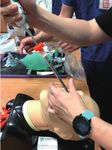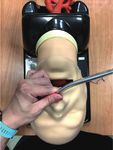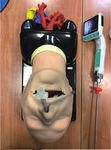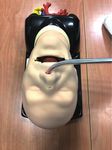Role of Trachway versus Conventional Modes of Intubation in Difficult Airway Management in COVID-19 Setups
←
→
Page content transcription
If your browser does not render page correctly, please read the page content below
Hindawi
Emergency Medicine International
Volume 2021, Article ID 6614523, 6 pages
https://doi.org/10.1155/2021/6614523
Research Article
Role of Trachway versus Conventional Modes of Intubation in
Difficult Airway Management in COVID-19 Setups
Meng-Yu Wu ,1,2 Giou-Teng Yiang,1,2 Jian-Yu Ke,3,4 Chien-Sheng Chen,1,2 Po-Chen Lin,1,2
and Yu-Long Chen 1,2
1
Department of Emergency Medicine, Taipei Tzu Chi Hospital, Buddhist Tzu Chi Medical Foundation, 231 New Taipei, Taiwan
2
Department of Emergency Medicine, School of Medicine, Tzu Chi University, 970 Hualien, Taiwan
3
Department of Emergency and Critical Care Medicine, Fu Jen Catholic University Hospital, Fu Jen Catholic University,
New Taipei City, Taiwan
4
School of Medicine, College of Medicine, Fu Jen Catholic University, New Taipei City, Taiwan
Correspondence should be addressed to Yu-Long Chen; yulong0129@gmail.com
Received 19 November 2020; Revised 22 January 2021; Accepted 2 February 2021; Published 26 February 2021
Academic Editor: Kee Chong Ng
Copyright © 2021 Meng-Yu Wu et al. This is an open access article distributed under the Creative Commons Attribution License,
which permits unrestricted use, distribution, and reproduction in any medium, provided the original work is properly cited.
Difficult airway management in critically ill patients remains a difficult task associated with high morbidity and mortality rates. In
difficult airway populations, prompt effective intubation is more important to prevent hypoxia and neurological injury. During
the ongoing COVID-19 pandemic, prolonged intubation time and repeated intubation can lead to an increase in the risk of
infection. Therefore, digital devices can shorten intubation times and decrease the risk of infection among clinical staff. The
advantages of the Trachway videolight intubating stylet suit these conditions. Trachway stylet intubation is an effective method for
video laryngoscopy to enhance patient safety and improve the intubation success rate. However, a few studies have focused on the
effect of stylet intubation by reducing repeated intubation and oxygen desaturation. In this study, we reviewed current data of
Trachway intubation and shared our four major training scenarios in Taipei Tzu Chi Hospital via the Trachway videolight
intubating stylet system for emergency intubation, comparing them with other modes of intubation.
1. Introduction conventional direct laryngoscope intubation. However, di-
rect laryngoscope intubation is difficult under several
During this critical era of the ongoing COVID-19 pandemic, conditions (cervical spinal cord injuries, facial injury, and
airway intubation faces a challenge for high risk of COVID- temporomandibular joint rigidity). The advantage of the
19 infection, increased number of infected patients, straining Trachway videolight intubating stylet suits these conditions
health-care systems, and crashing local economies. Several and provides effective intubation, compared to direct lar-
types of video laryngoscopy have been reported to shorten yngoscopy. In addition, the Trachway videolight intubating
intubation times and decrease the risk of infection among stylet can also be transformed to video laryngoscopy by
clinical staff [1–3]. The Trachway videolight intubating stylet changing the J-shape stylet to the laryngoscope blade. Thus,
system (Biotronic Instrument Enterprise Ltd., Tai-Chung, one system is made to have two effective intubation
Taiwan) is a J-shape stylet fabricated using stainless steel, methods. The transformation from Trachway video laryn-
which is promoted for tracheal intubation because it easily goscopy to Trachway video intubating stylet is easy and
passes through the oral cavity. The Trachway consists of quick. In this ongoing pandemic, the Trachway may sig-
three parts: a video recorder at the end of the stylet, grip, and nificantly decrease the risk of COVID-19 infection by im-
screen. The video stylet can allow physicians to visualize the proving the preparedness of frontline doctors during
vocal cords and endotracheal tube passage. In general in- emergency intubation, especially in emergency medical
tubation, the patient is placed in a sniffing position for students, residents, and fellows. In this study, we reviewed2 Emergency Medicine International
current data of Trachway intubation and shared our data in stylet assistance. In the Trachway stylet group, the total
Taipei Tzu Chi Hospital. We equally used the Trachway intubation time and duration of using tools to advancing the
videolight intubating stylet system to create four major tube into the trachea were significantly shorter, compared to
scenarios for emergency intubation in COVID-19 patients, the laryngoscope group. The median score of the modified
comparing them with other modes of intubation. nasotracheal intubation difficulty scale was higher in the
laryngoscope group. During intubation, up to 38% of pa-
2. Methods tients needed cuff inflation and 54% patients needed BURP
maneuver in the laryngoscope group, but no patients needed
Our training program was held from August 2019 to June assistance in the Trachway group. The mean total intubation
2020. It included four training courses (Table 1). The time in the Macintosh laryngoscope is about 2 min for
manikin was placed on a standard stretcher, and our pro- trainees and 1 min for experienced intubators with Magill
gram was carried out in the emergency department. The four forceps, and the Trachway stylet nasointubation has a
training courses were carried out on Laerdal Airway shorter mean total intubation time, 32.3 sec [6, 7]. Our study
™
Management Trainer (Laerdal Medical Ltd, Orpington,
UK) for medical students, residents, and fellows. In difficult
then provides supportive evidence for Trachway stylet
nasointubation in difficult airway management, especially in
airway management, the manikin was set up with an en- patients with limited mouth opening. In our third scenario,
larged manikin tongue to create an upper airway obstruc- we used the Trachway stylet for nasal intubation in a difficult
tion. The four training courses included direct laryngoscopy, airway (Figure 2). First, secretions of the oropharynx or
video laryngoscopy, Trachway stylet, and surgical airway. hypopharynx may impede the view of the trachea. Suction
Before the four scenarios, all trainees participated in two- with the DuCanto catheter, at least using Yankauer, may
hour training lectures. After training lectures, the scenarios improve the view. Second, slowly inserting the tip of the
were performed immediately. In each scenario, we requested endotracheal tube with the Trachway stylet from the selected
all trainees to perform endotracheal intubation thrice. In the nostril by the left hand is important to prevent epistaxis,
first scenario, we compared the efficacy of the Trachway which may cause poor visualization of the pharynx. The tip
stylet to direct laryngoscopy and video laryngoscopy for of the Trachway stylet is recommended to hind the inner tip
intubation in normal adults. In the second scenario, we of the endotracheal tube to prevent blurring. Finally, the
compared the Trachway stylet to direct laryngoscopy, video Trachway is often held in the right hand, and the left hand
laryngoscopy, and surgical airway for difficult airway can assist the insertion of the tip of the endotracheal tube
management. In the third scenario, we used the Trachway through the left nostril. After the tip of the endotracheal tube
stylet for nasal intubation in a difficult airway. In the fourth passes through the nostril, it rotates 90° and elevates while
scenario, we simulated the intubation in COVID-19 patients crossing the midline as it fits the anatomy curve of the
by direct laryngoscopy and video laryngoscopy in protective nasopharynx and oropharynx (Figure 3). In view of the
cover (Table 1). laryngopharynx, the tip of the endotracheal tube was ad-
vanced to the target depth in a routine manner.
3. Result
3.1. Trachway System in Orotracheal Intubation. The 3.3. Trachway System in COVID-19 Intubation. In the fourth
Trachway intubating stylet for digital intubation was in- scenario, we simulated the intubation in COVID-19 pa-
duced by Ong et al. [4] in 2009, and they reported that the tients. The trainers were intubated in an acrylic protective
duration of intubation is approximately 21–25 seconds in cover designed by Dr. Lai Hsien-yung (available at https://
manikins, which is adequate for clinical use. The Trachway sites.google.com/view/aerosolbox/home) to decrease the
intubating stylet provided an alternative tool for intubation. risk of contamination [8]. This device consists of an acrylic
The Trachway intubating stylet is an intubating stylet just box with an opening side to receive the patient’s head and
like a lightwand but with a camera for direct observation neck and two small holes for the intubator’s hands on the
(Figure 1). During intubation, the Trachway stylet is inserted opposite side. The monitor of the Trachway can be dis-
along the midline of the tongue to view the glottis. After the connected to the stylet and placed out of the box to prevent
stylet passed through the glottis, the vocal cords would come risk of contamination. A Trachway with a stylet or video
into view, and then, the endotracheal tube is slid into the laryngoscope was more effective for intubation (Figure 4). In
trachea. Using Trachway stylet intubation may not need to the acrylic box, direct laryngoscopy is more difficult for
change head or neck position to facilitate intubation, and in intubation due to limitations of hand motion and visuali-
a population with limited mouth opening, it may provide zation in small spaces. Video laryngoscopy is more suitable
more easy intubation. for the modified acrylic protective cover. To prevent risk of
contamination, the Trachway system could wirelessly con-
3.2. Trachway System in Nasotracheal Intubation for Difficult nect with the monitor. In addition, this system can connect
Airway. In recent years, the efficacy of the Trachway stylet with more than one monitor at the same time, thereby
system in nasotracheal intubation has been investigated. Hsu providing an effective teaching tool for medical students.
et al. [5] reported that 100 patients for oromaxillofacial In this study, we also searched the PubMed databases for
surgery received nasotracheal intubation (NCT01917409) in articles published from inception to October 2020. No limits
comparison with the Macintosh laryngoscope and Trachway were applied to our Boolean search strategy using theEmergency Medicine International 3
Table 1: Four scenarios of the training program and simulation setting.
Scenarios Classification Devices
Scenario 1 Normal intubation Trachway stylet vs. direct/video laryngoscopy
Scenario 2 Difficult intubation Trachway stylet vs. direct/video laryngoscopy and surgical airway
Scenario 3 Difficult intubation (nasal intubation) Trachway stylet
Scenario 4 COVID-19 intubation in protective cover Direct laryngoscopy vs. video laryngoscopy
Figure 1: The tip of the Trachway intubating stylet is also equipped with the light, just like a lightwand, for guiding into the trachea by
transillumination of the neck tissues.
(a) (b) (c) (d)
(e) (f ) (g) (h)
(i) (j) (k)
Figure 2: Using a Trachway stylet for nasointubation. (a) Inserting the tip of the endotracheal tube with a Trachway stylet from the selected
nostril, (b) using the left hand to control the force and prevent from epistaxis, (c) 90-degree rotation and elevation of the Trachway stylet at
the same time to midline, (d) making the curve of the Trachway stylet fit the anatomy curve of the nasopharynx and oropharynx, (e, f ) the tip
of the endotracheal tube was advanced to the target depth in a routine manner, (g, h) the view of inserting the tip of the endotracheal tube
with the Trachway stylet in the nasopharynx, (i) the view of the tip of the endotracheal tube in the oropharynx, (j) the view of the tip in the
laryngopharynx, and (k) the view of the tip of the endotracheal tube passing through the vocal cord.4 Emergency Medicine International
Figure 3: After the tip of the endotracheal tube is inserted into the selected nostril, 90-degree rotation (red arrow) and elevation (yellow
arrow) of the Trachway stylet at the same time to midline make the curve to fit the anatomy curve of the nasopharynx and oropharynx.
(a) (b) (c)
Figure 4: (a) Trachway with a stylet or video laryngoscope is more effective to prevent contamination wirelessly. (b, c) Trachway system
intubation is suitable to different acrylic protective covers.
keywords in bracket (“Trachway,” “Trachway intubation,” inexperienced physicians, and the effect of Trachway stylet
”difficult airway,” “video laryngoscopes,” and “intubation”). intubation is similar to that of other video laryngoscopes. In
References from retrieved articles were also examined to Tseng et al.’s [9] manikin study, 36 medical students without
identify other relevant articles. Studies were included if they previous experience in tracheal intubation were included to
used Trachway intubation systems. Studies were excluded if compare the Trachway intubation stylet and airway scope
they were irrelevant to the study’s aim or were animal video laryngoscope. Overall success rates did not differ
studies. In total, 23 articles were included in the discussion significantly between Trachway stylet intubation and video
analysis. laryngoscopy. In intubation time, there was no significant
difference as well. Kim et al. [10] found that the success rate
4. Discussion for tracheal intubation is similar, but stylet intubation
provided faster and easier intubations than the airway scope
Airway management in critically ill patients, suspected to be video laryngoscope. On comparing the Trachway intubating
infected with COVID-19, by emergency physicians is a stylet and Macintosh direct laryngoscopy in a manikin study
challenge, especially in difficult airways. In the current with 38 nurse anesthesiologists, it was revealed that the
concept, shortening the intubation time and indirect intu- Trachway intubating stylet had shorter intubation times and
bation would decrease the risk of contamination. The role of proved easier with intubations than direct laryngoscopy in
video laryngoscopy and digital video stylet has become difficult airway management, but no difference was observed
increasingly important for orotracheal intubation in high- in the normal airway. In addition, the Trachway intubating
risk patients [1–3]. Trachway stylet intubation is friendly for stylet did not have any complication event as the directEmergency Medicine International 5
laryngoscope [11]. In Cooney et al.’s [12] study, attending intubation. The Trachway stylet-assisted nasotracheal intu-
and resident emergency physicians were included for in- bation was prevented from blind advancement by direct
tubation of a difficult airway in high-fidelity simulated pa- visualization of the path through the nasal cavity. The distal
tients with stylet intubation in comparison with direct tip of the Trachway stylet can be positioned in the naso-
laryngoscopy. The results showed a 100% first attempt tracheal tube to prevent damage to the nasal tissues.
success rate and a lower cumulative attempt time in the stylet Therefore, using the Trachway stylet for nasointubation is an
intubation group. In current data, a Trachway with Mac- alternative tool for difficult airway management and a rescue
intosh laryngoscopy for intubation is recommended for method for emergency conditions [16].
medical learners. However, in experienced intubators
(residents and fellows), the learning curve of Trachway stylet 5. Conclusions
intubation is shorter. Hence, Trachway stylet intubation is a
more effective, faster, and easier method, especially for In this study, we shared with our experience and concluded
difficult airway management. from previous reported studies that the Trachway stylet
In difficult airway management, awake intubation is a intubation system provided more effective, faster, and higher
good choice but requires a skilled operator to perform it. success rates of intubation than direct laryngoscopy. In
Many video intubation devices provide an alternative addition, the advantages of the Trachway system included
method for physicians to awake tracheal intubation. The wireless connection, reducing the risk of contamination
Trachway video stylet has a similar size but more rigidity during airway management in COVID-19 patients.
compared to fibers. During Trachway awake intubation, the
traditional transtracheal block, spray-as-you-go technique, Data Availability
is not attempted because of the lack of a working channel in
this device. A novel modified method for Trachway awake No data were used to support this study.
intubation is needed [13]. The Trachway stylet and a 6 Fr
suction tube were inserted into the lumina of a size 7 or Conflicts of Interest
larger endotracheal tube through the side-arm orifice of the
double-swivel connector. After administration of lidocaine The authors declare that there are no conflicts of interest
injection into the trachea from inner suction tube, an en- regarding the publication of this paper.
dotracheal tube was further advanced into the trachea. The
Trachway stylet and suction tube were removed without the Acknowledgments
endotracheal tube. Poor visualization is a major problem in This study was supported by a grant from Taipei Tzu Chi
Trachway awake intubation. Oral secretions during the Hospital (TCRD-TPE-110-31, TCRD-TPE-110-34, and
intubation process may cause poor visualization even after TCRD-TPE-110-48).
oral secretion. In obese or limited mouth opening pop-
ulation, excess airway tissue also leads to this problem. A jaw
thrust or head-tilt maneuver may improve visualization
References
during intubation. Poor visualization may prolong duration [1] D. J. Brewster, N. Chrimes, T. B. Do et al., “Consensus
of intubation and increase discomfort to the conscious statement: safe airway society principles of airway manage-
patient, especially in obese patients. In facilitating tracheal ment and tracheal intubation specific to the COVID-19 adult
intubation, the Trachway is reported effective in anesthetized patient group,” Medical Journal of Australia, vol. 212, no. 10,
patients with difficult airway. In Hung et al.’s [13] report, we pp. 472–481, 2020.
found that Trachway video stylet awake intubation is an [2] T. M. Cook, K. El-Boghdadly, B. McGuire, A. F. McNarry,
alternative tool for difficult airway, especially in an emer- A. Patel, and A. Higgs, “Consensus guidelines for managing
the airway in patients with COVID-19,” Anaesthesia, vol. 75,
gency condition [14].
no. 6, pp. 785–799, 2020.
The efficacy of the Trachway stylet system for emergency [3] M. Sorbello, K. El-Boghdadly, I. Di Giacinto et al., “The Italian
nasotracheal intubation has been investigated. In a study by coronavirus disease 2019 outbreak: recommendations from
Lee et al. [15], 80 patients with limited mouth opening clinical practice,” Anaesthesia, vol. 75, no. 6, pp. 724–732,
undergoing oromaxillofacial surgery were included and the 2020.
results showed the mean total intubation time was signifi- [4] J. Ong, C.-L. Lee, H.-Y. Lai, Y. Lee, T.-Y. Chen, and
cantly shorter in the Trachway group. In the modified nasal M.-H. Shyr, “A new video intubating device: Trachway
intubation difficulty scale analysis, only 55% of patients in intubating stylet,” Anaesthesia, vol. 64, no. 10, 1145 pages,
the fiberoptic intubation group were categorized as having 2009.
no difficulty with intubation unlike 100% of patients in the [5] H.-T. Hsu, C.-H. Lin, K.-Y. Tseng et al., “Trachway in as-
Trachway group. There were no significant differences in sistance of nasotracheal intubation with a preformed naso-
tracheal tube in patients undergoing oral maxillofacial
complication rates (bleeding from the nostril, accumulation
surgery,” British Journal of Anaesthesia, vol. 113, no. 4,
of blood in the oropharyngeal space, postoperative sore pp. 720-721, 2014.
throat, hoarseness, and pain on swallowing) between the two [6] P. M. Jones, K. P. Armstrong, P. M. Armstrong et al., “A
groups. Trachway stylet nasotracheal intubation provided comparison of glidescope videolaryngoscopy to direct lar-
shorter intubation time, better intubation conditions, and yngoscopy for nasotracheal intubation,” Anesthesia & Anal-
similar complication rates, compared with fiberoptic gesia, vol. 107, no. 1, pp. 144–148, 2008.6 Emergency Medicine International
®
[7] Y. Hirabayashi, “Glidescope videolaryngoscope facilitates
nasotracheal intubation,” Canadian Journal of Anesthesia/
Journal Canadien d’anesthésie, vol. 53, no. 11, p. 1163, 2006.
[8] J. Y. Tseng and H. Y. Lai, “Protecting against COVID-19
aerosol infection during intubation,” Journal of the Chinese
Medical Association, vol. 83, no. 6, p. 582, 2020.
[9] K. Y. Tseng, S. W. Chau, M. P. Su, C. K. Shih, I. C. Lu, and
K. I. Cheng, “A comparison of Trachway intubating stylet and
airway scope for tracheal intubation by novice operators: a
manikin study,” Kaohsiung Journal of Medical Sciences,
vol. 28, no. 8, pp. 448–451, 2012.
[10] J. K. Kim, J. A. Kim, C. S. Kim, H. J. Ahn, M. K. Yang, and
S. J. Choi, “Comparison of tracheal intubation with the airway
scope or Clarus video system in patients with cervical collars,”
Anaesthesia, vol. 66, no. 8, pp. 694–698, 2011.
[11] K. C. Hung, P. H. Tan, V. C. Lin, H. K. Wang, and H. S. Chen,
“A comparison of the Trachway intubating stylet and the
Macintosh laryngoscope in tracheal intubation: a manikin
study,” Journal of Anesthesia, vol. 27, no. 2, pp. 205–210, 2013.
[12] D. R. Cooney, N. L. Cooney, H. Wallus, and S. Wojcik,
“Performance of emergency physicians utilizing a video-
assisted semi-rigid fiberoptic stylet for intubation of a difficult
airway in a high-fidelity simulated patient: a pilot study,”
International Journal of Emergency Medicine, vol. 5, no. 1,
p. 24, 2012.
[13] K.-C. Hung, “A novel modified method of using Trachway
intubating stylet for awake tracheal intubation in patients with
anticipated difficult airway,” Acta Anaesthesiologica Taiwan-
ica, vol. 51, no. 2, pp. 90–93, 2013.
[14] T. Gaszynski and E. Gaszynska, “The Clarus video system
stylet for awake intubation in a very difficult urgent intuba-
tion,” Anestezjologia Intensywna Terapia, vol. 45, no. 3,
pp. 153-154, 2013.
[15] M. C. Lee, K. Y. Tseng, Y. C. Shen et al., “Nasotracheal in-
tubation in patients with limited mouth opening: a com-
parison between fibreoptic intubation and the Trachway,”
Anaesthesia, vol. 71, no. 1, pp. 31–38, 2016.
[16] Y. T. Chen, C. N. Ho, and K. C. Hung, “Successful endo-
tracheal intubation with Trachway after failed fiber-optic
manipulations in a patient with retropharyngeal cervical
chordoma,” Ci Ji Yi Xue Za Zhi, vol. 29, no. 3, pp. 174–176,
2017.You can also read



























































